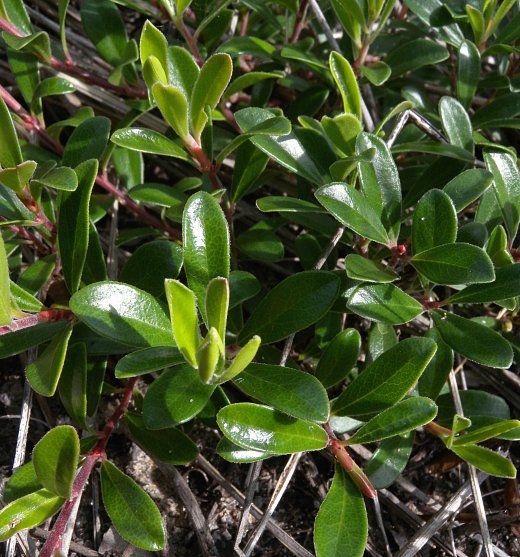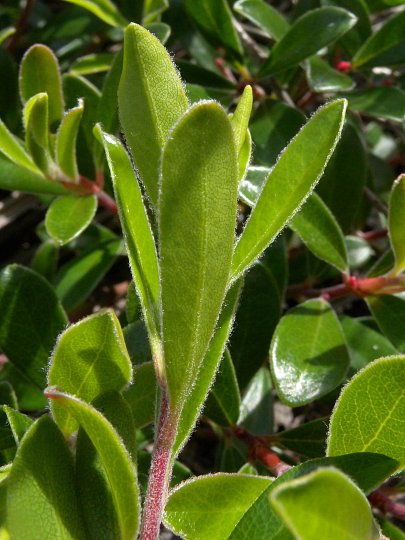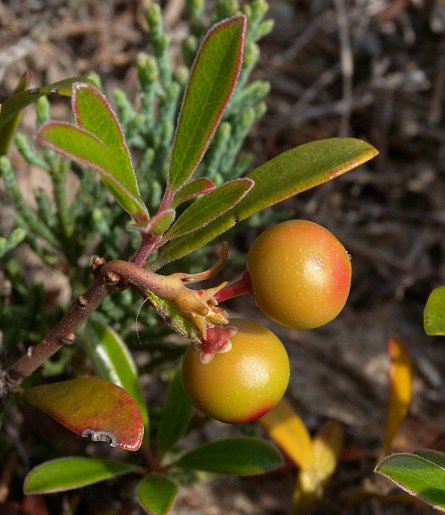
The corolla is constricted around its neck, above which there are 5 tiny lobes that are recurved and half-orbicular in shape. The interior of the corolla is hairy. The lobed calyx is predominately light green to red; its lobes have white- membranous margins. Both the peduncle and pedicels of the inflorescence are light green to red, glabrous to short-pubescent, and terete. The blooming period occurs from late spring to early summer, lasting about 2-3 weeks. Afterwards, fertile flowers are replaced by drupes that develop during the summer. Mature drupes are ¼–½" across, globoid to subgloboid in shape, smooth, and bright red. The fleshy interior of each mature drupe is dry, mealy, and tasteless, containing 4-5 hard seeds that are irregularly shaped. The woody root system can extend 3-6' into the ground. This shrub reproduces primarily by layering; when its branches and shoots become submerged in sand or soil, they can develop new roots. By this means, clonal colonies are produced. To a lesser extent, this shrub also reproduces by reseeding itself. The evergreen leaves become red to dark red during the winter.

Cultivation: The preference is full or partial sun, dry conditions, and sterile soil containing acidic rocky material or sand. Growth and development is slow. This winter-hardy evergreen shrub can be started from rooted cuttings. It can be used as a low ground cover in sunny rock gardens. The long-lasting drupes can persist into autumn, winter, and early spring.
Range & Habitat: The native Bearberry occurs primarily in northern Illinois, where it is rare and state-listed as 'endangered' (see Distribution Map). However, some large healthy populations of this low shrub can be found along the sand dunes of Lake Michigan. Illinois lies along the southern range-limit of this species. Bearberry has a wide distribution in boreal areas of North America; it also occurs in boreal areas of Eurasia. Habitats include dry sandy woodlands, dry sandy prairies, sandstone glades, exposed sandstone cliffs, and sand dunes along Lake Michigan. In the latter habitat, Bearberry is often codominant with Trailing Juniper (Juniperus horizontalis). This conservative shrub is found in high quality natural areas. It is also cultivated occasionally in gardens. Wildfire resistant is relatively poor, although some crowns and submerged rooted branches can survive light fires (Crane, 1991).

Faunal Associations: The urn-shaped flowers are probably cross-pollinated by long-tongued bees, where both nectar and pollen are available as floral rewards. A relatively small number of insects feed on the leaves and other parts of Bearberry. These species include two aphids, Tamalia coweni and Wahlgreniella nervata; Clastoptera saintcyri (Heath Spittlebug); two leafhoppers, Limotettix arctostaphyli and Texananus cumulatus; the larvae of two butterflies, Callophrys augustinus (Brown Elfin) and Callophrys polios (Hoary Elfin); and the larvae of a Pyralid moth, Pyla arenaeola (see Hottes & Frison, 1931; Hamilton, 1982; DeLong, 1948; Opler & Krizek, 1984; and Panzer et al., 2006). Two polyphagous insects, Lepidosaphes ulmi (Oystershell Scale) and Pseudococcus sorghiellus (Trochanter Mealybug), also reportedly feed on Bearberry. Foliage of Bearberry is browsed sparingly by White-tailed Deer and Elk. However, it is consider unpalatable and slightly toxic to horses, cattle, and other livestock. The fruits of this shrub are eaten by various upland gamebirds, songbirds, black bears, and small mammals, especially during the winter and early spring, as a source of emergency food (see Crane, 1991; Martin et al., 1951/1961; Rumble & Anderson, 1996). Most of these observations for vertebrate animals have occurred in the western United States and Canada.
Photographic Location: Sand dunes along Lake Michigan at Illinois Beach State Park in NE Illinois.

Comments: Along with Trailing Juniper (Juniperus horizontalis), Bearberry (Arctostaphylos uva-ursi) plays an important role in stabilizing the sand dunes along Lake Michigan in NE Illinois. It is typically found along the slopes or the tops of such dunes. Taller shrubs that colonize this area include Low Common Juniper (Juniperus communis depressa), Sand Cherry (Prunus pumila), and Chokecherry (Prunus virginiana). Bearberry has attractive flowers, fruits, and foliage throughout the year. Because of its wide distribution, there is some variability across different populations, and different varieties/subspecies have been described. Bearberry resembles another species in the Heath family, American Wintergreen (Gaultheria procumbens), in appearance. This latter species can be distinguished by its somewhat larger leaves (1-2" long), the wintergreen aroma of its leaves when they are crushed, the spicy flavor of its fruits, and the more pointed calyces of its flowers. It produces solitary flowers from the leaf axils, rather than clusters of 2-15 flowers from the tips of twigs. Another common name of Arctostaphylos uva-ursi is Kinnikinnik. This was originally an Amerindian name for this shrub; its dried leaves were often used as an ingredient in tobacco by them.